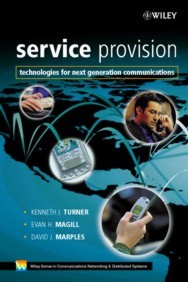Structure
Sample Chapter
Reference Material
Last Update 12th January 2020
Service Provision -
Technologies for Next Generation
Communications Systems

|
Contents
Introduction
Structure Sample Chapter Reference Material Last Update 12th January 2020 |
Service Provision -
|
The book has been divided up into self-contained topics. Each chapter can therefore be read in isolation. Although there is a logical progression in the book, chapters can be read in any order. The book can therefore be used for familiarization with the field, reading the chapters in the order written. The book can also be used for reference, reading individual chapters for more depth on particular topics.
However certain topics such as call processing, quality of service, service architecture and feature interaction tend to be recurring themes. They are touched on where relevant, but can be studied in more depth in the specialist chapters on these topics.
This part considers how networks support communications services.
Chapter 1 (Introduction and Context) sets the scene for the whole book. It overviews the nature of communications services and the approaches taken to developing them.
Chapter 2 (Multimedia Technology in A Telecommunications Setting) explains how communications services have grown rapidly to include multimedia as a central provision. The issues surrounding multimedia are explored, presenting the key standards that support multimedia services.
Chapter 3 (Call Processing) explains the major aspects of call processing. A variety of call models is introduced, along with switch-based services. Call processing is explained for (advanced) intelligent networks and softswitches.
Chapter 4 (Advanced Intelligent Networks) explains the origins of intelligent networks and the motivation for their development. The architecture and major functions are presented for the (Advanced) Intelligent Network. A variety of Intelligent Network services is introduced, including internationally standardized services and service features.
Chapter 5 (Basic Internet Technology in Support of Communication Services) introduces the main areas in which Internet technology impacts service provision. Approaches to Internet Quality of Service are discussed. A topical solution for Internet Telephony is explored. Directory-Enabled Networks are described as a means of achieving better management interoperability. Home Networks and Active Networks are discussed as examples of emerging Internet-based networks.
Chapter 6 (Wireless Technology) reviews a range of wireless solutions supporting a variety of different geographical areas. The evolution of cellular systems is traced through the first, second and third generations, with particular emphasis on the emerging Third Generation mobile systems. Other wireless systems addressed include broadcast networks and local wireless networks.
This part considers the architecture, creation, development and analysis of services.
Chapter 7 (Service Management and Quality of Service) focuses on the management of services, using Service-Level Agreements and Quality of Service as the basis. Mechanisms are discussed in depth for managing and monitoring Quality of Service.
Chapter 8 (Securing Communication Systems) deals with the important question of security as it affects services. The basic principles of cryptography are explained, along with the kinds of threats to which communications systems are subject. Mechanisms are introduced for authentication, non-repudiation and access control. Digital cash is used as a case study to illustrate how security issues arise and are dealt with.
Chapter 9 (Service Creation) examines service creation as pioneered in the (Advanced) Intelligent Network. The Telcordia SPACE system is used as a concrete example of a Service Creation Environment. Service creation is also considered for Internet services such as Internet Telephony and the Web. The important topics of service integration and service introduction are discussed.
Chapter 10 (Service Architectures) starts by reviewing two early efforts relevant to service architecture standardization: Open Systems Interconnection and the Distributed Computing Environment. The evolution of distributed services is then discussed in the context of subsequent standards: Open Distributed Processing, the Telecommunications Information Networking Architecture, and the Common Object Request Broker Architecture. The chapter also highlights the increasing importance of the middleware paradigm for service provision.
Chapter 11 (Service Capability APIs) focuses closely on specific programming interfaces for creating services: the Telecommunications Information Networking Architecture, Java APIs for The Integrated Network, and various Parlay APIs.
Chapter 12 (Formal Methods for Services) explains the nature of a formal method, and how it can be used to help service design. As examples, it is explained how services were formalized for Open Systems Interconnection and Open Distributed Processing. General classes of formal methods are discussed for modeling communications services.
Chapter 13 (Feature Interaction: Old Hat or Deadly New Menace?) explores feature interaction in general, and in the context of telephony. Reactions to the problem are presented from the perspective of researchers, operators and vendors. The changing nature of feature interaction is discussed in the context of how services are evolving.
This part looks at the evolution of communications services and their supporting technologies.
Chapter 14 (Advances in Services) examines factors such as convergence and context that are driving new kinds of services. Presence-based services, messaging services and service discovery are considered, all augmented by wireless connectivity. Home-based services are also discussed in depth.
Chapter 15 (Evolving Service Technology) explores new kinds of techniques being used to create communications services: software agents, constraint satisfaction, Artificial Neural Networks, and Genetic Programming.
Chapter 16 (Prospects) rounds off the book by evaluating the approaches developed for communications services. It discusses trends in the kinds of services that will be deployed and how they will be created. A mid- to long-term projection is presented of how services will evolve.
References gives details of all articles referenced throughout the book, and provide further reading for more detailed study.
Abbreviations collects in one place the major acronyms used throughout the book.
Glossary briefly defines some key terms used in the book.
Web Sites covers the major online sources for organizations discussed in the book, such as standardization bodies and trade associations.
 Up one level to Wiley Book Page
Up one level to Wiley Book Page